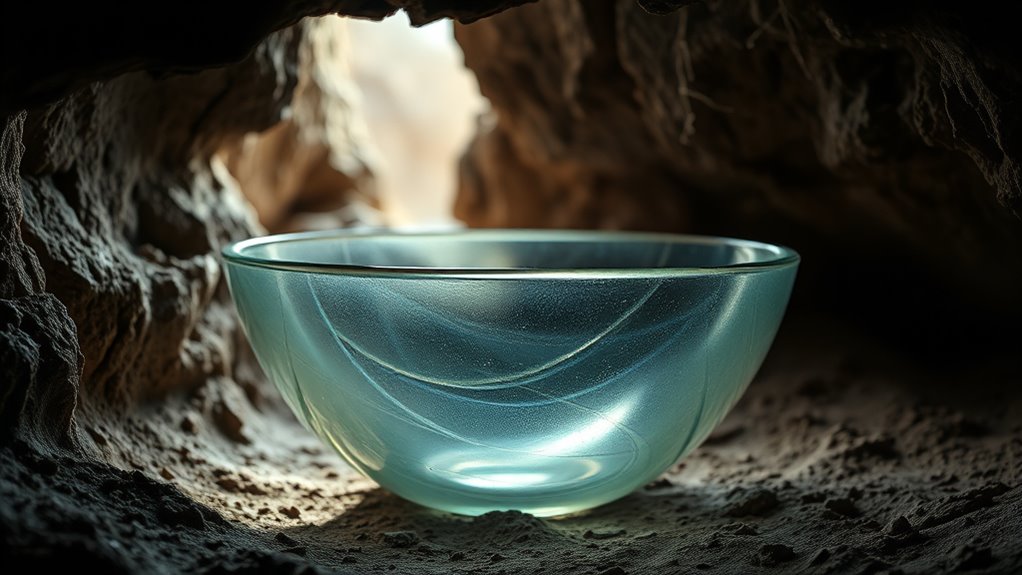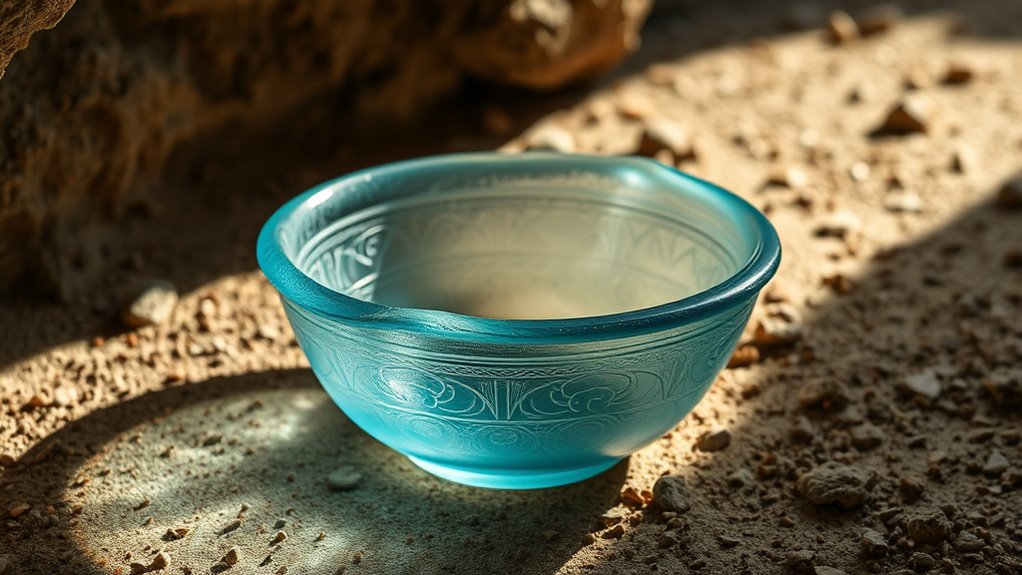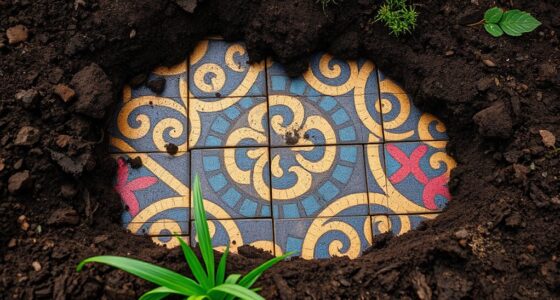Archaeologists have uncovered a rare, pristine 2,000-year-old Roman glass bowl hidden deep inside an Israeli cave. Its condition offers a unique glimpse into ancient craftsmanship, showing off the mastery of Roman artisans who created delicate, beautiful glassware. The cave’s stable environment helped preserve the artifact’s original form. Exploring these finds reveals secrets about daily life and craftsmanship from that era. If you keep exploring, you’ll discover more fascinating details about this remarkable discovery.
Key Takeaways
- A rare Roman glass bowl dating back nearly 2,000 years was discovered intact deep inside an Israeli cave.
- The artifact’s pristine condition offers valuable insights into ancient Roman craftsmanship and daily life.
- Cave preservation environment protected the bowl from deterioration, enabling detailed study without restoration.
- The bowl demonstrates Roman mastery in glass shaping, decorating, and coloring techniques.
- This discovery highlights the importance of archaeological preservation in uncovering and understanding cultural heritage.

Archaeologists have discovered a stunning Roman glass bowl deep inside a remote cave, offering new insights into ancient craftsmanship and daily life. This remarkable find highlights the sophistication and skill of Roman artisans, showcasing their mastery in working with glass nearly two millennia ago. As you examine the artifact, you realize how this piece reflects the high level of craftsmanship that Roman artisans achieved, combining both utility and artistry. The delicate curves, smooth surface, and clarity of the glass reveal the advanced techniques used to produce such fine objects. This discovery not only sheds light on Roman aesthetic sensibilities but also demonstrates the importance they placed on glassware as a symbol of wealth and status in their society.
Roman glass bowl reveals ancient craftsmanship, blending utility and artistry with exquisite detail and clarity.
The preservation of this artifact has been nothing short of exceptional. Thanks to the cave’s stable environment, the glass remained largely intact, resisting the typical deterioration seen in other ancient objects. This superb archaeological preservation allows you to study the bowl in its original form, providing invaluable information about the techniques and materials employed by Roman glassmakers. Because the object survived in such pristine condition, it offers a rare opportunity to analyze ancient craftsmanship firsthand, helping you understand the methods used to shape, decorate, and color Roman glass. The careful preservation also minimizes the need for invasive restoration, ensuring that the artifact remains as close to its original state as possible. Preservation techniques played a crucial role in protecting this delicate object from the effects of time and environmental factors. Additionally, modern archaeological methods have been vital in documenting and analyzing this discovery.
This find underscores the significance of archaeological preservation in uncovering history’s secrets. By maintaining the integrity of such artifacts, archaeologists enable future generations to explore and appreciate the cultural and technological achievements of ancient civilizations. You realize that every crack or imperfection, or the absence thereof, can tell a story about the conditions in which the object was kept, the techniques used in its creation, and the daily life of the people who crafted and used it. The cave’s environment played a critical role in maintaining the bowl’s condition, acting as a natural safeguard against the elements and human interference. Additionally, this discovery emphasizes the importance of archaeological preservation techniques that protect such delicate objects from deterioration over time. The environmental stability of the cave is a prime example of how natural conditions can aid in artifact preservation and help maintain the original appearance of ancient objects. The meticulous documentation during excavation further ensures that details about the artifact’s context are preserved for scholarly study.
This discovery also highlights the importance of conservation efforts in safeguarding cultural heritage for future research and public education. In the broader scope of archaeological discovery, this Roman glass bowl exemplifies how careful excavation and preservation efforts reveal invaluable relics of the past. As you reflect on this find, it becomes clear that such artifacts are more than just objects—they’re windows into history, craftsmanship, and culture. With each new discovery, we deepen our understanding of ancient societies and the incredible skills they possessed, reminding us of the enduring legacy of human ingenuity.
Frequently Asked Questions
How Was the Bowl Preserved for Two Millennia?
You might wonder how the bowl stayed preserved for two millennia. It’s thanks to the ancient craftsmanship that made it durable, combined with exceptional preservation conditions in the cave. The stable temperature, low humidity, and isolation from sunlight created an ideal environment, preventing decay. These factors helped protect the glass, allowing it to remain intact over such a long period, giving you a rare glimpse into ancient history.
What Techniques Are Used to Date Ancient Glass Artifacts?
You can date ancient glass artifacts using techniques like analyzing glass composition and radiocarbon dating. By examining the specific minerals and elements in the glass, you determine its age based on known historical production methods. Radiocarbon dating helps if organic residues are present, providing a more precise timeline. Together, these methods help archaeologists accurately establish the age of glass artifacts, revealing their historical context and significance.
Could the Bowl Have Held Any Specific Type of Liquid?
You might wonder if the bowl held a specific ancient liquid. Given its glass preservation, it’s possible it contained oils, perfumes, or medicinal substances common in Roman times. The bowl’s design and age suggest it was used for storing valuable liquids. While we can’t know for sure, the state of preservation indicates it once held something treasured, and its ancient liquid residue could reveal fascinating insights into Roman daily life.
Are Similar Artifacts Found in Other Caves Nearby?
They say, “History repeats itself,” and in nearby caves, similar artifacts can sometimes be found, revealing a pattern. You’ll notice cave formations and artifact distribution hint at ancient trade routes or cultural exchanges. While not all caves hold treasures like this bowl, the presence of comparable items suggests a broader archaeological significance, offering glimpses into the past and how ancient societies interacted with their environment and each other.
What Is the Significance of This Discovery for Roman History?
This discovery is significant for Roman history because it sheds light on Roman commerce and ancient craftsmanship. You can see how skilled artisans crafted glassware, revealing trade networks and cultural exchange during that era. The intact bowl offers insights into daily life and artistic techniques, helping you understand the sophistication of Roman society and their trade practices. It’s a rare glimpse into the craftsmanship that fueled Roman economic and cultural expansion.
Conclusion
As you imagine uncovering this ancient Roman glass bowl, you realize it’s more than just a relic—it’s a glimpse into a world long gone. The fact that it’s intact hints at secrets waiting to be uncovered, mysteries buried for centuries. What stories does this fragile artifact hold? As you stand there, the silence of the cave feels heavy with history, leaving you with a sense that this discovery might just change everything you thought you knew.









